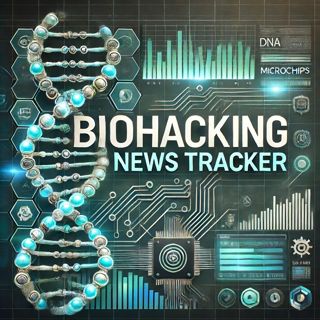
Biohacking Boom: Unlocking the Future of Health and Wellness
The biohacking industry has experienced significant growth in recent years, driven by heightened health consciousness, improved information accessibility, and a burgeoning entrepreneurial ethos. According to the Biohacking Global Market Report 2024, the market size is expected to grow from $29.42 billion in 2023 to $36.41 billion in 2024 at a compound annual growth rate (CAGR) of 23.7%[1].Key trends in the biohacking industry include biohacking for longevity, wearables, nootropics, sleep optimization, and genetic editing such as CRISPR. The market is expected to see exponential growth in the next few years, reaching $86.53 billion in 2028 at a CAGR of 24.2%[1].Emerging competitors and new product launches are contributing to the industry's growth. Companies like Apollo Neuro, Elo Health, and FightCamp are developing innovative technologies to meet the demand for biohacking tools. For example, Apollo Neuro offers a wearable device that uses vibrations to improve stress resilience and sleep quality, while Elo Health provides personalized nutrition through AI analysis and biomarker test data[3].Regulatory changes are also shaping the industry. While there are no clear guidelines on biohacking as an individual vertical, the Food and Drug Administration (FDA) has jurisdiction over most biohacking products and biologics in the US. Internationally, there is a need for state regulation that explicitly monitors biohacking to ensure standardized testing and safety requirements[5].Consumer behavior is shifting towards a greater focus on health and wellness, driving demand for biohacking products and services. The rise of DIY biology and the maker culture is also contributing to the industry's growth. However, there are concerns about the uncontrolled dissemination of unproven biohackers and the need for clear labeling and accurate information about biohacking products and services[5].Industry leaders are responding to current challenges by investing in research and development, partnering with regulatory bodies, and promoting education and awareness about biohacking. For example, companies like Jinfiniti Precision Medicine are curating lists of impactful biohacking strategies and providing resources for consumers to navigate the industry[2].Compared to the previous reporting period, the biohacking industry has seen significant growth and development. The market size has increased, and new trends and technologies have emerged. However, regulatory challenges and concerns about safety and ethics remain. As the industry continues to evolve, it is essential for industry leaders, regulatory bodies, and consumers to work together to ensure the safe and effective development of biohacking products and services.This content was created in partnership and with the help of Artificial Intelligence AI
6 Dec 20243min

The Rise of Biohacking: Transforming Health and Longevity
The biohacking industry is experiencing rapid growth, driven by heightened health consciousness, improved information accessibility, and a burgeoning entrepreneurial ethos. Recent market reports indicate that the global biohacking market size is projected to grow significantly over the next few years.According to Research and Markets, the biohacking market will grow from $29.42 billion in 2023 to $36.41 billion in 2024 at a compound annual growth rate (CAGR) of 23.7%[1][3]. This growth is attributed to increased health awareness, access to information, and the quantified self movement. The market is expected to reach $86.53 billion by 2028, with a CAGR of 24.2%, driven by longevity and anti-aging focus, nootropics, mainstream adoption, corporate wellness programs, and evolving regulations.Key trends in the forecast period include biohacking for longevity and anti-aging, biohacking wearables and devices, nootropics and cognitive enhancement, biohacking for sleep optimization, and genetic editing technologies such as CRISPR[1][3].The wearables segment is a significant contributor to the market growth, with a share of 29.9% in 2023, according to Grand View Research[2]. The diagnosis and treatment segment held the largest revenue share of over 32.3% in 2023, driven by the high usage of biohacking practices for body enhancement purposes.North America dominated the market in 2023 with a market share of 36.7%, followed by Europe with a share of over 30%[2]. The Asia Pacific region is anticipated to witness significant growth, with a CAGR of 20.6%, driven by rising healthcare expenditure and economic growth in the region.Major companies in the biohacking market include Thync Global, Inc., Health Via Modern Nutrition Inc., Apple Inc., The ODIN, Fitbit, Inc., Nuanic, and Muse, which are transforming well-being by combining technology, science, and human performance[2].In terms of recent developments, there have been significant advancements in wearable technology, genetic testing kits, and smart devices, which allow people to track and analyze their biometric data, leading to a more personalized and data-focused biohacking approach[2].Consumer behavior is shifting towards a more proactive approach to health, with individuals seeking methods to enhance their lifespan, prevent or deal with health issues, and optimize their mental and physical abilities. This trend has significantly boosted the utilization of biohacking tools and methods to enhance lifespan, overall health, and mental and physical abilities.Industry leaders are responding to current challenges by investing in research and development, focusing on technological progress, and incorporating Artificial Intelligence for personalized suggestions. For example, health sensors on wearable devices are transforming the fitness and wellness industry, allowing people to manage their health and well-being more effectively.In comparison to the previous reporting period, the biohacking market has seen exponential growth, driven by increased health awareness, access to information, and the quantified self movement. The market is expected to continue growing rapidly, with a focus on longevity and anti-aging, nootropics, and genetic editing technologies.Overall, the biohacking industry is experiencing significant growth, driven by technological advancements, changing consumer behavior, and increasing investments in research and development. As the market continues to evolve, it is expected to have a profound impact on the healthcare and wellness industry.This content was created in partnership and with the help of Artificial Intelligence AI
4 Dec 20244min

Biohacking's Transformative Impact: Personalized Health Tech Drives Rapid Industry Growth
The biohacking industry is experiencing rapid growth, driven by increasing health consciousness, advancements in wearable technology, and the rising trend of personalized healthcare. Recent market movements indicate a significant expansion in the global biohacking market size, projected to reach USD 155.63 billion by 2033, growing at a CAGR of 19.42% from 2024 to 2033[3].Key drivers of this growth include the availability of wearable health trackers, genetic testing kits, smart devices, and apps that allow people to track and analyze their biometric data, leading to a more personalized and data-focused biohacking approach[2]. The wearables segment accounted for a share of 29.9% in 2023, with current developments focusing on technological progress, such as adding additional health functions and incorporating Artificial Intelligence for personalized suggestions[2].The Asia Pacific biohacking market is anticipated to witness significant growth, with a CAGR of 20.6%, driven by the rise in healthcare expenditure and the population's willingness to invest in their health and explore innovative ways to improve it[2]. The U.S. biohacking market size was estimated at USD 7.77 billion in 2023 and is predicted to be worth around USD 46.11 billion by 2033 at a CAGR of 19.49%[3].Emerging competitors and new product launches are also contributing to the market's growth. Major companies in the biohacking market, such as Thync Global, Inc., Health Via Modern Nutrition Inc., Apple Inc., The ODIN, Fitbit, Inc., Nuanic, and Muse, are transforming well-being by combining technology, science, and human performance[2].Regulatory changes and significant market disruptions are also shaping the industry. The increasing adoption of biohacking practices by forensic institutes is expected to support the segment's growth, with a CAGR of more than 21.5% during the forecast period[2].Consumer behavior is shifting towards a more proactive approach to health, with individuals seeking methods to enhance their lifespan, prevent or deal with health issues, and optimize their mental and physical abilities. The rising prevalence of chronic diseases and the need for more potent therapies are driving pharmaceutical and biotechnology companies to invest in biohacking research and development[3].In response to current challenges, industry leaders are focusing on developing new applications for biohacking, advancing medical knowledge, and making biohacking interventions more accessible. For example, hospitals and clinics are frequently at the forefront of biohacking research and development, working with government organizations, biotech firms, and academic institutions to investigate cutting-edge methods, treatments, and technologies[3].Compared to the previous reporting period, the biohacking market has seen a significant increase in market size, with a growth rate of 19.42% from 2024 to 2033[3]. The industry is expected to continue its rapid expansion, driven by the increasing awareness of health and wellness, advancements in wearable technology, and the rising trend of personalized healthcare.This content was created in partnership and with the help of Artificial Intelligence AI
1 Dec 20243min

Biohacking Boom: Tracking the Rapid Growth and Emerging Trends in the Global Wellness Tech Market
The biohacking industry is experiencing rapid growth, driven by increasing awareness of health and wellness, advancements in wearable technology, and the rising trend of personalized healthcare. The global biohacking market size was valued at various figures in 2023, ranging from USD 18.75 billion to USD 27.19 billion, depending on the source[1][2][5]. However, all reports agree on a significant compound annual growth rate (CAGR) ranging from 15.42% to 19.8% over the forecast period.Key drivers of the market include the rising prevalence of chronic diseases, the need for individualized treatment strategies, and the growing demand for health monitoring and preventive healthcare. The wearables segment is expected to hold the greatest share of the global biohacking market, with advanced health smartwatches and sensors accounting for a significant revenue share[1][4][5].North America is currently the largest market for biohacking, attributed to its advanced healthcare infrastructure, high adoption rates of wearable technologies, and significant investments in research and development. The Asia Pacific region is predicted to grow at the fastest pace, driven by rapid advancements in biotechnology and healthcare innovations, as well as increasing healthcare expenditure[2][3][5].Recent market movements include the increasing popularity of biohacking activities such as nootropics and genetic engineering. Pharmaceutical and biotechnology companies are investing heavily in biohacking technology, leading to the development of new biohacking methods and applications[2][3][4].Emerging competitors in the biohacking market include companies focusing on nutrigenomics, which studies how nutrition and natural compounds affect human genes to support good health. The biohacking community has also influenced cultural values, safety, medical ethics, and consent in transhumanistic technology[5].In terms of regulatory changes, there is growing emphasis on developing faster medications, therapies, and personalized health solutions, with greater regulatory support for new biohacking applications in drug development[4].Significant market disruptions include the rapid increase in biohacking seen in countries like Sweden, where private and public companies offer implants to their employees. The UK also sees many companies providing biohacking implants to employees[5].Consumer behavior is shifting towards a more personalized and data-focused biohacking approach, with individuals seeking methods to enhance their lifespan, prevent or deal with health issues, and optimize their mental and physical abilities. The current generation holds a favorable attitude towards biohacking and the tools associated with it[1].In response to current challenges, biohacking industry leaders are focusing on technological progress, such as adding additional health functions to wearable devices and incorporating Artificial Intelligence for personalized suggestions. They are also investing in research and development to improve treatment processes and make biohacking interventions more accessible[1][2][3].Comparing current conditions to the previous reporting period, the biohacking market has seen significant growth, driven by increasing awareness of health and wellness and advancements in wearable technology. The market is expected to continue growing at a rapid pace, with North America and Asia Pacific being key regions for market expansion.This content was created in partnership and with the help of Artificial Intelligence AI
29 Nov 20243min

The Biohacking Boom: Unlocking the Future of Personalized Health and Wellness
The biohacking industry is experiencing rapid growth, driven by increasing awareness of health and wellness, advancements in wearable technology, and the rising trend of personalized healthcare. Recent market movements indicate a significant expansion in the global biohacking market size, projected to reach USD 155.63 billion by 2033, growing at a CAGR of 19.42% from 2024 to 2033[2].Key factors contributing to this growth include the rising rates of chronic illnesses, the need for more potent therapies, and the increasing adoption of biohacking practices by individuals seeking to enhance their lifespan, prevent or deal with health issues, and optimize their mental and physical abilities[1][2]. The wearables segment, which includes advanced health smartwatches and fitness trackers, accounted for a significant share of the market in 2023, with a focus on technological progress such as adding additional health functions and incorporating Artificial Intelligence for personalized suggestions[1].The diagnosis and treatment segment held the largest revenue share in 2023, driven by the high usage of biohacking practices such as nootropics and wearable technologies for body enhancement purposes[1]. Hospitals and clinics dominated the biohacking market in 2023, attributed to their role in the forefront of biohacking research and development, working with government organizations, biotech firms, and academic institutions to investigate cutting-edge methods, treatments, and technologies[2].Emerging competitors and new product launches are also contributing to the market's growth. For instance, companies are focusing on biohacking the aging code through nutrigenomics, which studies how nutrition and natural compounds affect human genes to support good health[5]. The Asia Pacific region is expected to witness significant growth, driven by the increasing prevalence of chronic diseases, a rising middle class with disposable income, and heavy investments in biotechnology and healthcare innovations[3].Regulatory changes and significant market disruptions are also shaping the industry. For example, government initiatives and advantageous laws are encouraging the biohacking industry to expand in regions such as North America and Europe[2][3]. The pharmaceutical and biotechnology companies segment is observed to be the fastest growing in the biohacking market during the forecast period, driven by the need for novel solutions and the rising incidence of chronic diseases[2][3].Consumer behavior is shifting towards a more personalized and data-focused biohacking approach, with individuals seeking to track and analyze their biometric data using wearable health trackers, genetic testing kits, smart devices, and apps[1]. Supply chain developments include the increasing adoption of biohacking practices by forensic institutes, which are investing more in the research and development of biohacking practices to improve treatment processes[1][2].Industry leaders are responding to current challenges by combining technology, science, and human performance to transform well-being. For example, companies like Thync Global, Inc., Health Via Modern Nutrition Inc., Apple Inc., and Fitbit, Inc. are transforming well-being by combining technology, science, and human performance[1]. Overall, the biohacking industry is poised for significant growth, driven by technological advancements, increasing awareness of health and wellness, and the rising trend of personalized healthcare.This content was created in partnership and with the help of Artificial Intelligence AI
24 Nov 20243min

Biohacking Boom: Personalizing Health and Wellness Through Wearables and Biotechnology
The biohacking industry is experiencing rapid growth, driven by increasing awareness of health and wellness, advancements in wearable technology, and the rising trend of personalized healthcare. The global biohacking market size was valued at various figures in 2023, ranging from USD 18.75 billion to USD 27.19 billion, depending on the source[1][2][4]. However, all reports agree on a significant compound annual growth rate (CAGR) ranging from 15.42% to 19.8% from 2024 to 2033.Key drivers of the market include the rising prevalence of chronic diseases, the need for individualized treatment strategies, and the growing demand for health monitoring and preventive healthcare. The wearables segment is expected to hold the greatest share of the global biohacking market during the projected timeframe, with advanced health smartwatches and electrodermal activity sensors accounting for a significant revenue share[1][4].North America is expected to hold the largest share of the global biohacking market, attributed to the region's advanced healthcare infrastructure, high adoption rates of wearable technologies, and significant investments in research and development[2][3]. The Asia Pacific region is predicted to grow at the fastest pace, driven by rapid advancements in biotechnology and healthcare innovations, as well as increasing healthcare expenditure[2][3].Recent market movements include the increasing popularity of biohacking activities such as nootropics and genetic engineering. The pharmaceutical and biotechnology companies segment is expected to grow at the fastest rate, fueled by the growing emphasis on developing faster medications, therapies, and personalized health solutions[2][4].Emerging competitors and new product launches are also contributing to the market's growth. For example, companies are focusing on biohacking the aging code through nutrigenomics, which studies how nutrition and natural compounds affect human genes to support good health[5].Regulatory changes and significant market disruptions are also shaping the industry. The increasing adoption of biohacking practices by forensic institutes is expected to support the segment's growth, with these institutes investing more in the research and development of biohacking practices to improve treatment processes[1].Consumer behavior is shifting towards a more personalized and data-focused biohacking approach, with individuals seeking methods to enhance their lifespan, prevent or deal with health issues, and optimize their mental and physical abilities. The current generation holds a favorable attitude towards biohacking and the tools associated with it, leading to increased adoption of wearable analytical technological devices[1].In response to current challenges, biohacking industry leaders are focusing on technological progress, such as adding additional health functions, incorporating Artificial Intelligence for personalized suggestions, and sending live data to healthcare professionals for prompt interventions and better patient results[1].Compared to the previous reporting period, the biohacking market has seen significant growth, driven by increasing awareness of health and wellness, advancements in wearable technology, and the rising trend of personalized healthcare. The market is expected to continue growing at a rapid pace, with North America holding the largest share and the Asia Pacific region growing at the fastest pace.This content was created in partnership and with the help of Artificial Intelligence AI
22 Nov 20243min

The Booming Biohacking Industry: Personalized Health and Self-Optimization
The biohacking industry is experiencing rapid growth, driven by increasing interest in personalized healthcare and self-optimization. Recent market analyses indicate that the global biohacking market size was valued at approximately $22.86 billion in 2023 and is projected to reach $89.65 billion by 2031, growing at a CAGR of 18.6%[1].Key factors driving this growth include advancements in wearable technology, genetic testing kits, and smart devices that allow individuals to track and analyze their biometric data. The wearables segment accounted for a significant share of 29.9% in 2023, with current developments focusing on technological progress such as adding additional health functions and incorporating Artificial Intelligence for personalized suggestions[3].The Asia Pacific region is expected to witness significant growth, with countries such as China, India, and Japan investing heavily in biotechnology and healthcare innovations. The region's biohacking market size was valued at $5.11 billion in 2023 and is projected to reach $20.89 billion by 2031[1].North America dominated the market in 2023, with a market share of 36.7%, driven by the increasing prevalence of chronic illnesses, awareness of biohacking, and heavy investments in research and development[3].Recent trends in consumer behavior include a shift towards preventive health, with individuals seeking methods to enhance their lifespan, prevent or deal with health issues, and optimize their mental and physical abilities. The diagnosis and treatment segment held the largest revenue share of over 32.3% in 2023, with biohackers making data-driven decisions to improve their longevity and overall well-being[3].Industry leaders are responding to current challenges by focusing on developing faster medications, therapies, and personalized health solutions. Pharmaceutical and biotechnology companies are investing significantly in biohacking technology, driving the growth of the segment[4].In comparison to the previous reporting period, the biohacking market has seen an increase in the adoption of intelligent drugs and genetic modification kits. The market is also experiencing a rise in the use of biohacking practices by forensic institutes, with the forensic laboratories segment expected to record a CAGR of over 21.5% during the forecast period[3].Overall, the biohacking industry is rapidly expanding, driven by advancements in technology, increasing health consciousness, and the growing demand for personalized healthcare solutions. Industry leaders are responding to current challenges by investing in research and development, and the market is expected to continue growing at a significant rate in the coming years.This content was created in partnership and with the help of Artificial Intelligence AI
19 Nov 20243min

Biohacking Industry Booms: Exploring the Rise of Personalized Health Tech and its Global Impact
The biohacking industry is experiencing rapid growth, driven by increasing awareness of health and wellness, advancements in technology, and rising chronic diseases. Recent market movements indicate a significant expansion in the global biohacking market size, projected to reach USD 78.67 billion by 2033 at a CAGR of 15.42%[1]. Another report suggests a higher growth rate, with the market expected to reach USD 155.63 billion by 2033 at a CAGR of 19.42%[4].Key drivers of this growth include the increasing popularity of wearable devices and nootropics, particularly in North America, which dominated the market in 2023 with a share of 36.7%[2]. The wearables segment is expected to hold the largest share of the global biohacking market, driven by health consciousness, preventive health measures, and demand for health monitoring and preventive healthcare[1].Emerging competitors and new product launches are also contributing to the market's growth. Companies like Thync Global, Inc., Health Via Modern Nutrition Inc., Apple Inc., and Fitbit, Inc. are transforming well-being by combining technology, science, and human performance[2]. The pharmaceutical and biotechnology segment is expected to grow at the fastest rate, driven by the need for personalized treatment strategies and regulatory support for new biohacking applications in drug development[1].Regulatory changes and significant market disruptions are also shaping the industry. The increasing adoption of biohacking practices by forensic institutes is expected to support the growth of the forensic laboratories segment, which is projected to record a CAGR of more than 21.5% during the forecast period[2].Consumer behavior is shifting towards a more personalized and data-focused biohacking approach, with individuals seeking methods to enhance their lifespan, prevent or deal with health issues, and optimize their mental and physical abilities[2]. The Asia Pacific region is experiencing rapid growth, driven by increasing healthcare expenditure, technological advancements, and government initiatives[4].Industry leaders are responding to current challenges by investing in research and development, particularly in the Asia Pacific region. Companies like Epicenter in Sweden are offering implants to their employees, while in the UK, many companies are providing biohacking implants to their employees[3].Compared to the previous reporting period, the biohacking industry has seen significant growth, driven by increasing awareness of health and wellness, advancements in technology, and rising chronic diseases. The market is expected to continue growing, with North America dominating the market and the Asia Pacific region experiencing rapid growth.Key statistics and data from the past week include:- The global biohacking market size was valued at USD 26.38 billion in 2023 and is estimated to surpass around USD 155.63 billion by 2033 at a CAGR of 19.42%[4].- The U.S. biohacking market size was estimated at USD 7.77 billion in 2023 and is predicted to be worth around USD 46.11 billion by 2033 at a CAGR of 19.49%[4].- The Asia Pacific biohacking market size was calculated at USD 5.80 billion in 2023 and is projected to expand around USD 35.02 billion by 2033 at a CAGR of 19.69%[4].Overall, the biohacking industry is experiencing rapid growth, driven by increasing awareness of health and wellness, advancements in technology, and rising chronic diseases. Industry leaders are responding to current challenges by investing in research and development, particularly in the Asia Pacific region.This content was created in partnership and with the help of Artificial Intelligence AI
18 Nov 20244min





















